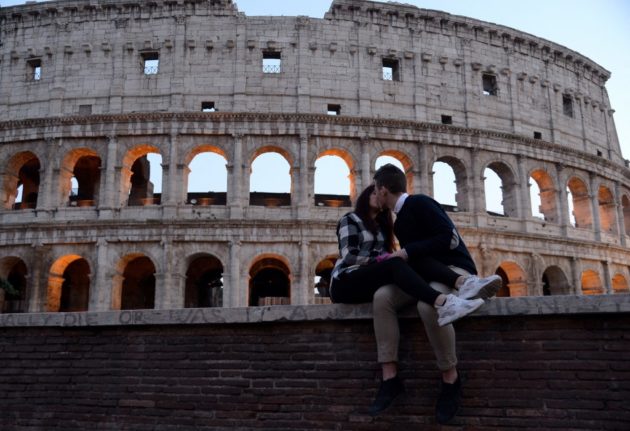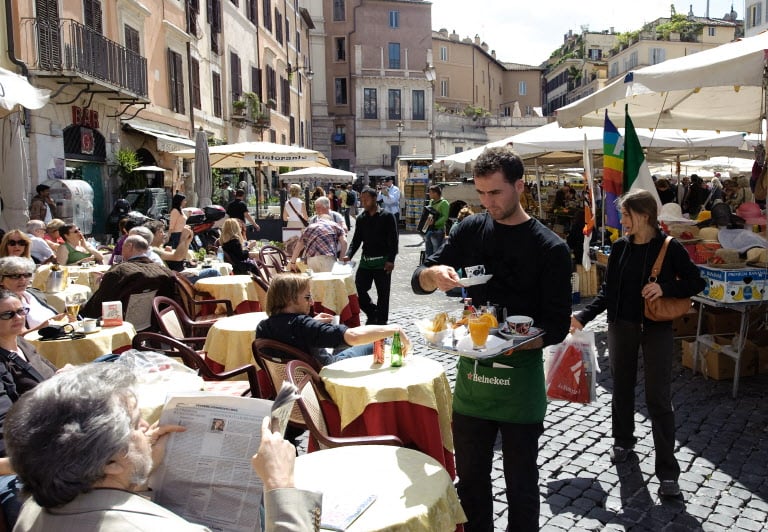When was the first Valentine’s Day?
It’s long been thought that Valentine’s Day may have started out as the Roman pagan festival of Lupercalia, which was celebrated on February 15th.
During the celebrations for Lupercalia, a goat (or goats) and a dog would be sacrificed, and priests known as luperci (‘brothers of the wolf’) would smear the blood on their foreheads, feast on the animals’ meat, and cut strips from their hides.
READ ALSO: Pompeii shows a Roman smooch for Valentine’s Day
According to the historian Plutarch, young noblemen would then run around the city naked or semi-naked, hitting bystanders with the flayed skin in a fertility ritual.
Women would stand in their way, hoping that getting struck with the thongs would help them conceive – or if they were already pregnant, that it would help the baby to be born healthy.
The idea goes that after Rome became Christianised in the fourth century, such indecorous displays would no longer do. In 496 AD, Pope Gelasius I is said to have banned Lupercalia and instead declared February 14th a day of sober celebration in honour of the martyred Saint Valentine.
READ ALSO: 11 of the most romantic places in Italy to escape the crowds
In reality, it’s now widely believed that Gelasius never succeeded in abolishing Lupercalia (though he did call participants ‘vile rabble’, and tried to get it banned), and the proximity of the two dates might just be a coincidence.
Historians these days credit Chaucer, writing in the 1300s, with being the first person to link February 14th with romantic love in his poem ‘Parliament of Fowls’.
Who was the real St Valentine?
There are at least a couple of figures associated with St Valentine – and they may well have been the same person.
One is a third century bishop, Valentinus, from the town of Terni in Umbria. This Valentinus restored the sight of a Roman judge’s daughter, and as a result converted the judge and his whole family to Christianity.
The judge released all the Christian prisoners under his control, and Valentinus continued to successfully evangelise throughout the land – until he started proselytising to Emperor Claudius II, who consequently had him beheaded.
READ ALSO: Five ways to have the perfect romantic weekend in Rome
The second is another third century priest named Valentine who was also martyred for rubbing the emperor up the wrong way.
Claudius was struggling to get recruits for his army, and blamed the problem on the overattachment of Roman men to their wives and girlfriends. As a result, he banned all marriages and engagements in the city.
Valentine saw this rule as unjust, and continued to marry lovers in secret in defiance of the edict. When he was found out, he was beaten to death and then beheaded.
As these two Valentines are from roughly the same time and place and met the same fate, it’s believed they may in fact have been the same person.
Various riffs on both stories include the idea that St Valentine distributed hearts cut from parchment to persecuted Christians to remind them both of the love of God and their vows to each other; and that he fell in love with either his jailor’s or the Roman judge’s daughter, sending her a letter signed ‘from your Valentine’.
READ ALSO: Ten phrases to arm you for your Italian date
No one really knows how much of this is true, and how much is legend. The origins and identity of Saint Valentine remain mysterious, and there are in fact ten Saint Valentines listed on the official Roman Catholic register of saints.
Still, you can pay tribute to at least one of them by visiting his skull at Rome’s Chiesa di Santa Maria in Cosmedin.

How is Valentine’s Day celebrated in Italy?
Most of Italy celebrates Valentine’s Day in pretty much the same way as the rest of the world: it’s less a Catholic festival than it is a fairly heavily commercialised holiday during which couples can expect to spend over the odds on a weekend away or a meal out.
That said, St Valentine is apparently the patron saint of multiple Italian towns, including (as you might expect) Terni, as well as Padua, Sadali in Sardinia, Quero and Pozzoleone in Veneto, Palmoli in Abruzzo, and Vico del Gargano in Puglia.
Each of these towns has their own way of celebrating the day – in Palmoli, the floor of the Church of Santa Maria delle Grazie is covered in laurel leaves, while Quero has a tradition of blessing oranges and throwing them off a hill nearby the Church of Saint Valentine for good luck.
Verona, where Shakespeare set Romeo and Juliet and which has appointed a particular balcony in the historic centre ‘Juliet’s balcony’, has embraced the kitschier aspects of the festival, and every year puts on the four-day-long Valentine-themed event ‘Verona in Love‘.
What does make Italy unique is the designation of February 15th as a day of celebration for single people, known as La Festa dei Single (Singles’ Day) or Festa di San Faustino (Feast of San Faustino), a date first thought up by lifestyle site La Vita da Single (Single Life) in 2001.
While it started out as something of a joke, the annual celebration of single life has become increasingly popular, with events marking the occasion in many of Italy’s big cities – ranging from sociable dinners for the happily single to speed-dating events for those looking for love.




 Please whitelist us to continue reading.
Please whitelist us to continue reading.
Member comments